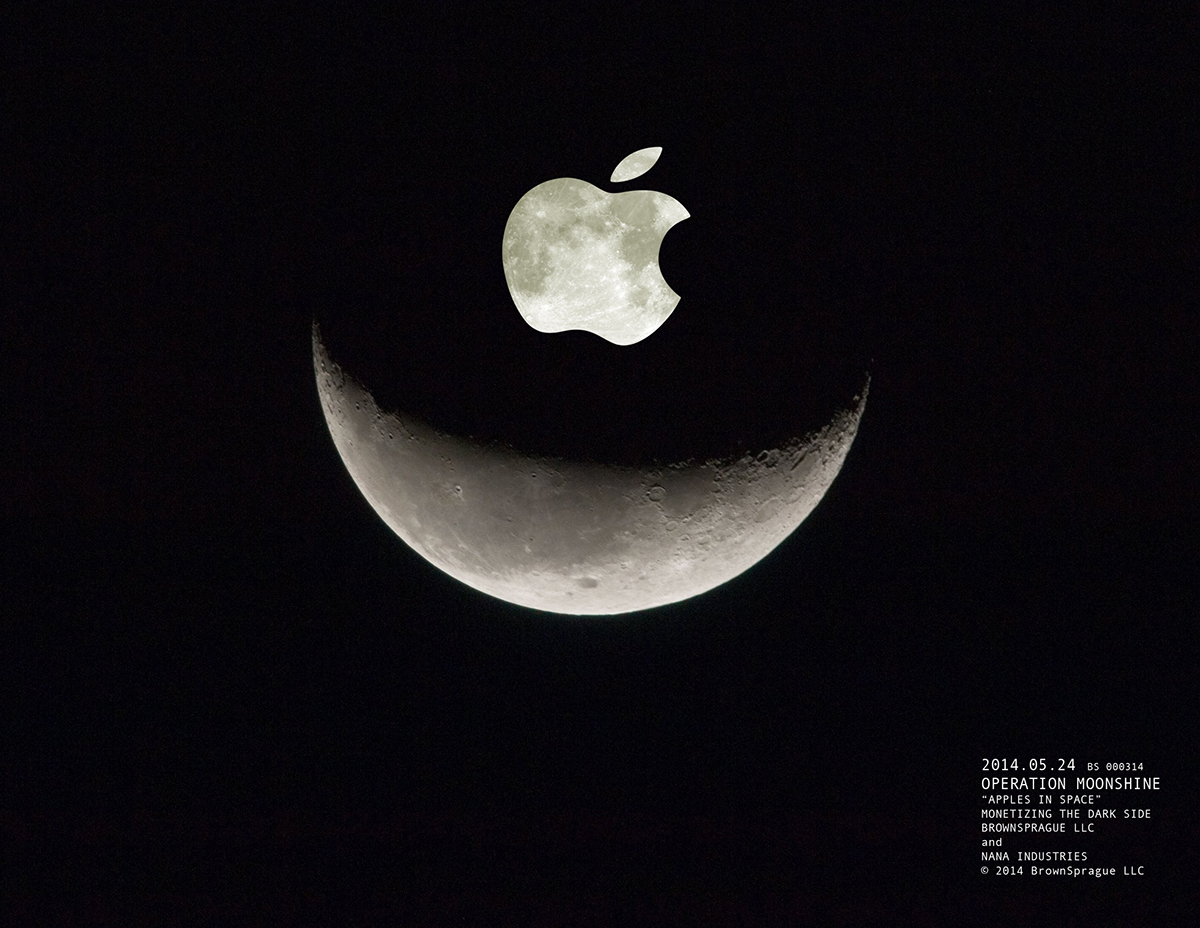




Operation Moonshine
aka., Monetizing the Moon’s Surface
by Peter Everett Brown
© 2014 BrownSprague LLC
Capturing our cognitive attention is the goal of every advertising or marketing campaign. Markets are willing to pay large sums in hopes of sending us a direct message. Space to accommodate this message is graded upon percentages of a likely audience and is indifferent to the message content, the intent of the messenger. In our present Age of Information, a fleeting moment, a glimpse and a fraction of seconds has systemic value to the messenger. Their goal: to establish a path to our subconscious and ultimately our
conscious state:
“Visual communication is communication through visual aid and is described as the conveyance of ideas and information in forms that can be read or looked upon. Visual communication in part or whole relies on vision,[1] and is primarily presented or expressed with two dimensional images, it includes: signs, typography, drawing, graphic design, illustration, colour and electronic resources. It also explores the idea that a visual message[2] accompanying text has a greater power to inform, educate, or persuade a person or audience.” Wikipedia 2013
The Sky:
Due to its ubiquitous presence; the sky has served as a canvas to deliver a message through history. Fire, smoke signals, fireworks, skywriting, balloons, blimps, banners, evening marquee lights, illuminated signs, billboards, etc. inhabiting the sky, have all sought to capture our attention and relay a message over long distances.
The smoke signal is one of the oldest forms of long-distance communication. Smoke signals are used to transmit news, signal danger, or gather people to a common area.
The first use of skywriting for advertising purposes was on November 28, 1922 over New
York City. Pilot and entrepreneur Andy Stinis developed commercial skywriting in the
United States in the early 1930s; who created the Skywriting Corporation of America in
1932. Pepsi-Cola became the first major brand to utilize skywriting as a medium that
could deliver mass market reach. In the decade before television became widespread, thousands of flights were undertaken for Pepsi-Cola, driving huge brand growth into the mid-1940s and a relationship with Skywriting Corporation of America that lasted over 60 years.
From The Role of Science Fiction, by Gareth L Powell 2009
“…A lot of people think science fiction writers try to predict the future in their stories. But accurately predicting the future is extremely difficult. Instead, what we try to do is to dream up plausible futures. We extrapolate sociological and technological trends and try to picture how they will affect the characters in our stories. We can imagine good futures and bad futures: utopias and dystopias. We can imagine futures where disease and hunger have been eradicated; and futures where repression and poverty are even more widespread than they are today. But how will we know what it’s like to live in those futures?
Good Science fiction looks at the world we know and asks: “What happens if?”
What happens if the ice caps melt and sea levels rise by fifty feet?
What happens if we discover a way to halt the ageing process and everyone lives for 1000 years?
What happens if the government puts a CCTV camera on every street corner?
In science fiction novels and stories, we get to experience and explore these futures through the eyes of the characters in the books. We get to put ourselves in their place and live through them. For instance, I’ve recently written a number of stories set in Bristol in the future. But in each of them, the future has been slightly different. In one, the city gets eaten by a plague of microscopic robots. In another, it’s rendered uninhabitable by an explosion at the Berkeley nuclear power station. In these stories, I’m not trying to explain the mechanics of how these events happen. Instead, I’m taking the reader on a journey, to give them an experience they’ve never had before, such as riding a motorbike through deserted city streets, or standing in a park looking out at all the familiar buildings in ruins.
In this respect, science fiction is useful as a tool, not for predicting the future, but for instead modeling a vast range of possible futures. As our society develops and changes, science fiction is there to show us what will happen if we continue along our current path…”
Monetization of Space:
Since the birth of space exploration men have sought means and methods to use
space technology for the advancement of science, the betterment of mankind and commercial endeavors, i.e. communication satellites. As we reach further into the unknown our technological expertise continues to grow. Science, aided by communication and computational technology continues to advance at an exponential rate. Knowledge and technologies generated by space exploration are now shared by nations and private enterprises. This idea is both attainable and more importantly inevitable.
Luna:
Since the history of man, earth’s moon has filled our hearts and minds with expectation, prophecy, lore and poetry. It is the ever-distant lover, prophet, sign and god, beyond our reach but forever in our dreams.
When the moon is visible from earth it has two sides, a light and dark side. While the light side of the moon receives most of the cheer the dark side is usually present, minus the crowd favorite full moon, it is the dark side of the moon that is the host of this study. The center of our solar system, the sun illuminates the planets, light from the sun is an abundant resource in space. Recent studies have pondered the possibility of redirecting sunlight to illuminate commercial and scientific fieldwork on surfaces such as the moon. An array of giant solar reflectors can orbit the moon indefinitely. Their position and movement can be controlled in a precise manner and can ultimately be choreographed to illuminate large regions of the moon’s dark side like projection onto a spherical movie screen.
So What?
The question I pose is a simple one. Will the surface of the moon be fair game to use as a vehicle for propaganda in the decades to come? If so, who will control it… for what means?

